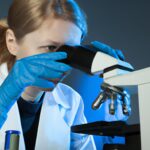Understanding Naturally Competent Bacterial Cells: How Bacteria Take Up DNA from Their Environment

Introduction to Bacterial Competence and DNA Uptake
Bacterial transformation is a process that enables certain bacterial cells to actively take up free, or “naked,” DNA from their surrounding environment. This ability, referred to as
natural competence
, is a major driver of bacterial evolution and adaptation, allowing rapid genetic changes without cell division. Naturally competent bacteria can integrate new genes, which may confer advantages such as antibiotic resistance or novel metabolic capabilities
[3]
. Understanding this process is critical in both basic research and applied biotechnology.

Source: quoteimg.com
What is a Naturally Competent Bacterial Cell?
A
naturally competent bacterial cell
is one that can take up DNA from its environment and incorporate it into its own genome. This process is known as
bacterial transformation
[5]
. Competence is not universal; it is a genetically regulated state found in select species such as
Bacillus subtilis
,
Streptococcus pneumoniae
,
Neisseria gonorrhoeae
, and
Haemophilus influenzae
. The genes and proteins involved in competence have been well characterized in model organisms.
The Mechanisms of DNA Uptake in Bacteria
The uptake of DNA is a multi-step process involving several specialized proteins and cellular structures:
Step 1: DNA Binding to the Cell Surface
Environmental double-stranded DNA (dsDNA) first binds to the surface of competent cells. This initial binding is facilitated by specific receptor proteins, such as ComEA, which anchor the DNA to the membrane [2] . In Gram-negative bacteria, this occurs at the outer membrane; in Gram-positive bacteria, it happens at the thick peptidoglycan layer [1] .
Step 2: DNA Transport into the Periplasm
In Gram-negative bacteria, DNA passes through a channel formed by secretin proteins in the outer membrane, often aided by a type IV pilus system. The DNA is then held in the periplasmic space by ComEA, which acts as a Brownian ratchet, preventing the DNA from diffusing backward [5] .
Step 3: Translocation Across the Cytoplasmic Membrane
DNA is then transported across the cytoplasmic membrane, typically as a single strand. The channel protein ComEC facilitates this step. During transport, nucleases degrade one strand of the DNA, allowing only the single-stranded DNA (ssDNA) to enter the cytoplasm [3] .
Step 4: Integration into the Bacterial Genome
Once inside the cytoplasm, the ssDNA is coated with single-strand binding proteins and integrated into the bacterial chromosome through homologous recombination, mediated by the RecA protein. This stable genetic change allows the bacteria to express new traits encoded by the acquired DNA [3] .
Real-World Examples of Natural Competence
Streptococcus pneumoniae
and
Bacillus subtilis
are classic models for studying bacterial transformation. In these species, competence is regulated by environmental signals, such as nutrient limitation or cell density. For instance, in
B. subtilis
, the ComK protein acts as a master regulator, turning on genes required for DNA uptake. In clinical contexts, natural competence has contributed to the spread of antibiotic resistance among pathogenic bacteria
[1]
.
How to Harness Bacterial Transformation in the Laboratory
Laboratory strains of naturally competent bacteria can be used to introduce foreign genes for research, industrial, or medical purposes. To perform transformation:
- Grow bacteria under conditions that induce competence (e.g., specific media, temperature, or cell density).
- Prepare purified DNA to be introduced.
- Add DNA to the culture and incubate to allow uptake.
- Select transformed cells using appropriate markers (e.g., antibiotic resistance).
For species that are not naturally competent, artificial methods such as chemical treatment (calcium chloride) or electroporation can be used to induce DNA uptake.
Challenges and Solutions in DNA Uptake
Several challenges exist when working with natural competence:
-
Species-Specific Uptake:
Some bacteria require specific DNA uptake sequences; using homologous DNA improves transformation frequency [2] . -
Environmental Conditions:
Competence is often tightly regulated and transient; optimizing induction protocols is essential. -
DNA Degradation:
Extracellular nucleases may degrade DNA before uptake; increasing DNA concentration and using nuclease inhibitors can mitigate this issue.
Alternative approaches include using competent strains engineered to be more receptive to transformation or employing electroporation for recalcitrant species.
Applications and Opportunities
Natural competence and transformation have critical applications in biotechnology:
-
Genetic Engineering:
Rapidly introduce new genes or traits into bacteria for synthetic biology or metabolic engineering. -
Vaccine Development:
Engineer attenuated strains for vaccine production. -
Antibiotic Resistance Studies:
Track and prevent the spread of resistance genes in clinical settings.
To access laboratory protocols or guidance on transformation, researchers can consult official microbiology textbooks or institutional resources. For regulatory or safety information, consult your institution’s biosafety office or the Centers for Disease Control and Prevention (CDC).
Step-by-Step Guidance for Researchers and Practitioners
If you wish to leverage bacterial transformation in your work:

Source: chegg.com
-
Identify a naturally competent species suitable for your application (e.g.,
B. subtilis
for genetic studies). - Consult published protocols in peer-reviewed journals for competence induction and transformation techniques. Search terms such as “bacterial transformation protocol” or “natural competence induction” can yield relevant results in databases like PubMed or ASM Journals.
- Ensure compliance with biosafety and institutional guidelines before conducting transformation experiments.
- For troubleshooting, review literature on competence regulation, DNA uptake sequences, and transformation efficiency in your target species.
- Contact your institutional biosafety officer or microbiology department for further assistance if needed.
Many research organizations provide training and technical support for transformation experiments. Consider attending workshops or webinars offered by professional societies such as the American Society for Microbiology.
Alternative Approaches to DNA Uptake
While natural competence is powerful, artificial transformation methods are available for non-competent bacteria. These include:
-
Chemical Transformation:
Treat cells with calcium chloride to permeabilize membranes. -
Electroporation:
Apply an electric pulse to create transient pores in the cell membrane.
These approaches require optimization and careful control of conditions but expand the range of species amenable to genetic engineering.
Summary and Key Takeaways
Bacterial cells described as naturally competent have the remarkable ability to take up DNA from their environment, allowing for rapid genetic change. This process is central to bacterial evolution, biotechnology, and the spread of clinically relevant traits. To harness natural competence, researchers should carefully select species, optimize experimental conditions, and consult authoritative resources. For non-competent bacteria, alternative transformation methods are available. For guidance or technical support, search for official protocols and consider contacting your local microbiology department or professional society.
References
- [1] ASM Journals (2021). Mechanisms of Transforming DNA Uptake to the Periplasm in Bacillus subtilis.
- [2] PubMed Central (2005). The Ins and Outs of DNA Transfer in Bacteria.
- [3] LibreTexts (2024). Bacterial Transformation – Microbial Genetics.
- [4] PNAS (2016). Kinetics of DNA Uptake during Transformation in Bacillus subtilis.
- [5] PubMed (2019). Mechanisms of DNA Uptake by Naturally Competent Bacteria.






